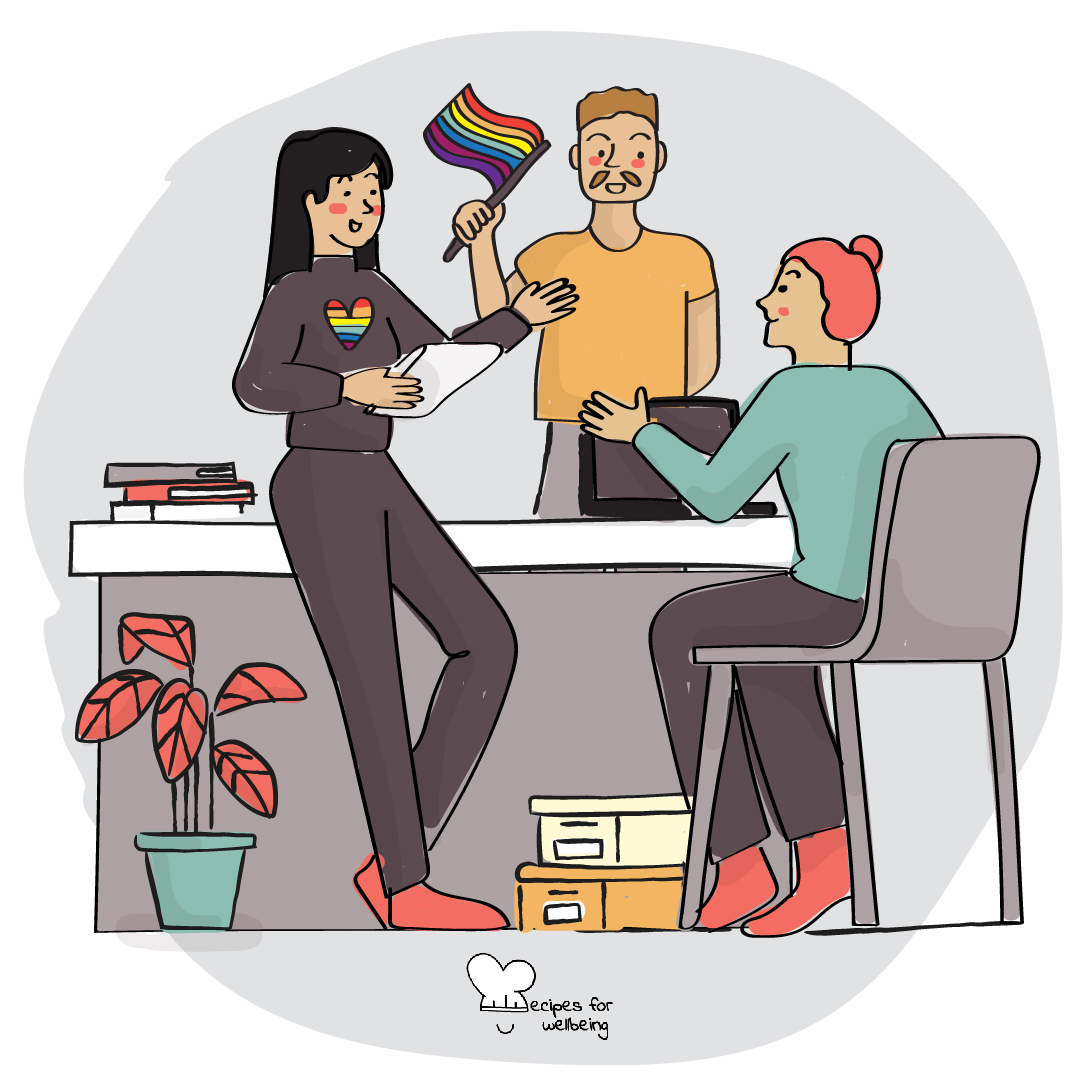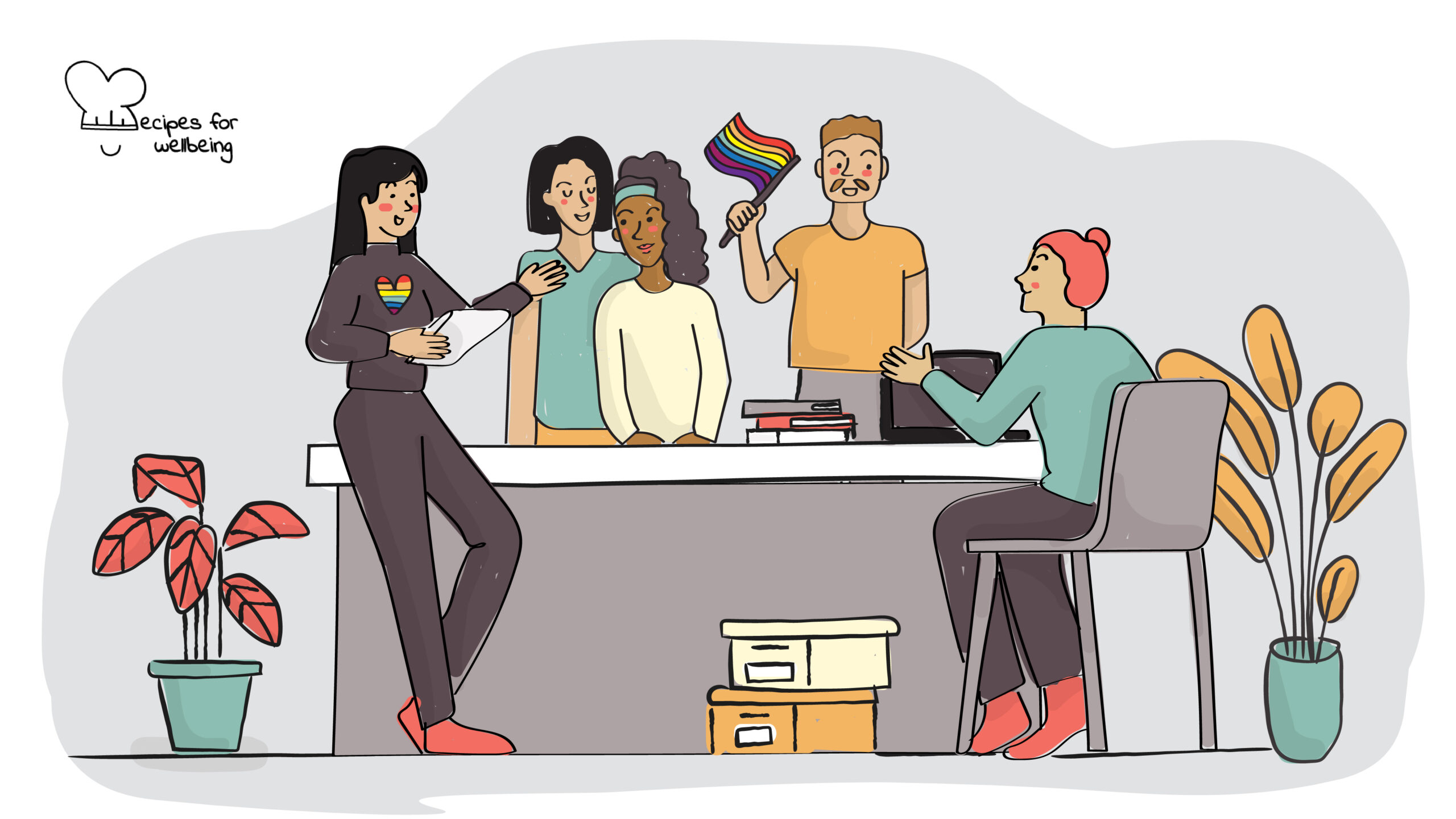
LGBTQIA2S+ allies in the workplace
It is not enough to be compassionate. You must act. ―Tenzin Gyatso
👥 Serves: 11-25 people, 2-10 people, 26-40 people, 41+ people
🎚 Difficulty: Easy
⏳ Total time: Ongoing
🥣 Ingredients: An open mind and heart
🤓 Wholebeing Domains: Awareness, Community, Liberatory Learning, Radical Care
💪 Wholebeing Skills: Allyship, Championing, Inclusion, Liberation, Non-judgement, Respect, Self-directed learning

LGBTQIA2S+ allies in the workplace
📝 Description
Be an active ally for LGBTQIA2S+ colleagues.
Did you know that 75% of LGBTQIA2S+ employees have experienced daily negative workplace interactions related to their LGBTQIA2S+ identity? While these numbers are disheartening and downright wrong, improving the wellbeing of diverse employees — including those who identify as LGBTQIA2S+ – starts with you, being a strong ally. Being an ally is a role that invites you to speak out against prejudice and discrimination, support the community and be active in the pursuit of ending oppression.
This recipe has been created by our wellbeing content writer collaborator Marissa Del Mistro.
👣 Steps
Step 1 – Educate yourself
Take the time to educate yourself about important details of the LGBTQIA2S+ community. Do not lean on an already marginalised group to educate yourself. Topics to brush up on:
- The 1969 Stonewall Rebellion and its impact on modern-day pride.
- The various groups within the LGBTQIA2S+ community and what they mean.
- Inclusive versus non inclusive language.
- Understand how to be an ally for trans folks.
- Read up about the community here and here.
- Face your personal biases that you may hold.
- LGBTQIA2S+ heroes.
Step 2 – Use inclusive language and pronouns
Language matters. There are several ways to be more inclusive in your language such as:
- Refer to your significant other and other people’s significant others as “partners”.
- Provide and use your pronouns in conversations, emails, online communications, etc.
- Trade gendered greetings such as “hey guys” to “hey team”.
- Ask people what their preferred pronouns are.
- Use people-first language that focuses on the individual, rather than their descriptor.
- Consider the historical context and implications of words and phrases to avoid using oppressive language/quotes.
Step 3 – Listen and be affirming
If someone at work wishes to discuss with you their experiences as an LGBTQIA2S+ person, this is not a chance to share an opinion or try to dissect their problem. It is, instead, a chance to be a strong, active listener. This person is trusting you with something very private and important and it’s a time to listen and affirm them. Check out our recipe “Active listening” to deepen your listening skills.
They may share something about their experience at work, which may be something you can take to upper management as something to address and to work on as a team. However, never share something said in confidence without consent.
Step 4 – Speak up
It is important to recognise and address offensive language and comments from others in the team. Should this occur, make it clear this type of language is not welcome. While these can be difficult conversations, they are essential to building a culture of mutual respect. You can call out comments in a productive manner by saying things such as:
- “Actually, how I act or what I say doesn’t define my sexual orientation and, most importantly, being gay isn’t an insult.”
- “What you just said was not okay. Don’t use gay in a negative way.”
- “What you just said is not appropriate.”
- “You may not have meant to be hurtful, but what you just said is hurtful.”
- “Even if that was a joke, it was not funny.”
- “Here’s why I’m offended, upset or hurt…”
- “That type of language is not welcome here.”
- “I am going to stop you right there.”
- “____ pronouns are they/them.”
- “_____ shared with us that their preferred pronouns are they/them. Let’s respect that.”
Step 5 – Act on your allyship
Never let your allyship be passive! Acknowledge your privilege as a heterosexual and/or cisgender person when visiting LGBTQIA2S+ safe spaces and continue to monitor the way you’re discussing issues.
Actions really do speak louder than words, and by actively participating where you can, you are confirming that you are interested and invested in the discussion around LGBTQIA2S+ rights and most importantly, willing to invest your time to help make changes. There are many ways you can support your LGBTQIA2S+ colleagues actively by:
- Join an employee support group as an ally.
- Take part in organisational pride events.
- Join or create fundraising initiatives to raise money for LGBTQIA2S cause(s).
- Be aware of all anti-discrimination policies within the organisation.
- Check out our recipe “Strategies to support LGBTQIA2S+ folks in the workplace” for additional ideas.

